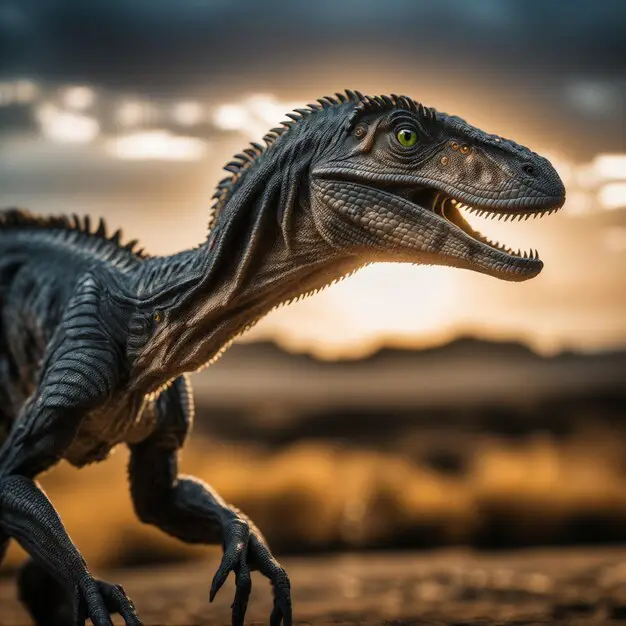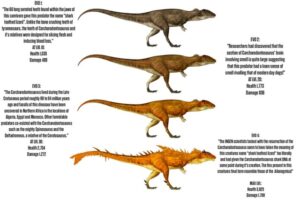Dinosaur is Velociraptor: Unveiling the Prehistoric Icon
The Velociraptor is a well-known species of dinosaur. It thrived during the Late Cretaceous period.
Velociraptors were small, agile predators that walked on two legs and are often depicted in popular culture as cunning hunters. They featured a distinctive sickle-shaped claw on each hind foot, which they likely used to tackle and incapacitate their prey.
Despite their portrayal in movies as large, towering creatures, real Velociraptors were actually about the size of a turkey and were covered in feathers. Paleontologists have made significant discoveries about these dinosaurs, primarily through fossil evidence found in Mongolia. They suggest that Velociraptors were social creatures, possibly hunting in packs, and they had a keen sense of smell and complex behaviors. Their fascinating biology and cultural impact solidify Velociraptor’s reputation as an iconic dinosaur.

Credit: m.facebook.com

The True Image Of Velociraptor
The Velociraptor, a dinosaur famed for its cunning and speed, has captivated both paleontologists and the public alike. Yet, the common portrayal of this dinosaur is far from accurate. Let’s unveil the true image of the Velociraptor, stripping away the layers of Hollywood fiction.
Physical Attributes And Size Comparisons
When we think of Velociraptors, we often envision large, terrifying predators. But in reality, these dinosaurs were much smaller. The truth lies in their physical attributes.
- Height: Stood at roughly 0.5 meters tall at the hip
- Length: Measured about 2 meters from head to tail
- Weight: Tipped the scales at around 15 to 20 kilograms
- Comparable in size to a modern domestic turkey rather than the towering beasts often depicted
To visualize, picture the Velociraptor beside a modern human. The dinosaur would barely reach an adult’s waist!
| Velociraptor | Modern Human | Domestic Turkey |
|---|---|---|
| 0.5m tall at the hip | ~1.75m tall | Up to 1.2m in length |
Feathered Evidence: Rethinking The Scaly Predator
Forget the scaly monsters seen in movies. Science suggests a different story. Fossil discoveries have uncovered that Velociraptors sported feathers.
These weren’t mere decoration but likely played a role in:
- Regulation of body temperature
- Display to attract mates or intimidate rivals
- Possibly aiding in flight or gliding, particularly for juveniles
Quill knobs: Evidence on the forearms of fossils points to wing-like structures, supporting the feathered theory.
This revelation paints an image of the Velociraptor as a sleek, feathered creature, bearing a striking resemblance to modern birds of prey rather than the scaly reptilian beasts of pop culture.
Velociraptor’s Habitat And Behavior
Picture a world where majestic dinosaurs roamed. Among them was the Velociraptor, a creature that captivates our wonder even today. The Velociraptor’s habitat and behavior reflect the life of a dynamic and adaptable dinosaur. This section delves into the ancient lands they ruled and their intriguing survival tactics.
Ancient Environments: Where Did Velociraptors Roam?
Velociraptors lived during the Late Cretaceous period. They thrived in what we now call Asia, across vast expanses like Mongolia and China. Their world was a mix of sandy dunes and occasional streams, a desert-like habitat with patches of vegetation.
- Sandy landscapes – home to these cunning predators.
- Oases – provided vital water resources.
- Diverse flora – offered hiding spots for hunting.
Hunter Or Scavenger? Insights Into Feeding Practices
Velociraptors were versatile in their diet. Their sharp teeth and claws suggest they were fearsome hunters. Yet, evidence also points to scavenging, a way to ensure survival in tough climates.
| Hunting Traits | Scavenging Clues |
|---|---|
| Curved claws for gripping prey | Teeth marks on bones of other predators’ kills |
| Agile frame for quick pursuits | Flexible diet to consume leftovers |
Whether hunting down a Protoceratops or feasting on a carcass, Velociraptors adapted to their environment with cunning intelligence. Their behavioral flexibility remains a fascinating aspect of their existence.
Unraveling Velociraptor Myths
Unraveling Velociraptor Myths: Velociraptors have captivated audiences for decades. Fascinating and fierce, they’re often depicted in ways that aren’t quite accurate. Let’s dive into the real story behind these prehistoric predators and separate fact from fiction.
Cinema Vs. Science: Debunking Hollywood Portrayals
The Velociraptor leaping off your screen is likely not the creature that once roamed the Earth. Movies often show these dinosaurs as towering, scaly monsters. In reality, they were much smaller and feathered. Let’s compare the differences:
| Feature | Hollywood’s Velociraptor | Real Velociraptor |
|---|---|---|
| Size | Large, over 6 feet tall | Small, around 2 feet tall |
| Skin | Scales | Feathers |
| Behavior | Often solo hunters | Likely hunted in packs |
Common Misconceptions About Velociraptor Intelligence
The idea that Velociraptors were genius hunters is a stretch. While they had smarts, much like modern birds, their intelligence might not have been as sophisticated as the movies suggest. Let’s bust some myths:
- Vision: They had good vision, but not necessarily the laser-like focus shown in films.
- Problem-Solving: They might solve simple problems, but not complex puzzles.
- Communication: They likely communicated, yet not in the intricate ways portrayed.
Real Velociraptors did have sharp claws and teeth. They were skilled hunters. But they were not the masterminds we see on screen.

Credit: www.freepik.com
Fossil Record And Discovery
The fossil record of Velociraptors unveils a captivating narrative of their existence. These fearsome predators once roamed the Earth during the Late Cretaceous period. Paleontologists unearth their remains to piece together the dinosaur’s lifestyle and behavior. The discovery of Velociraptor fossils has provided invaluable insights into the prehistoric world.
Significant Velociraptor Discoveries Over Time
Velociraptor fossils have been a treasure trove for scientists. Key finds stretch back to the first discovery in 1923 by Peter Kaisen. Osborn’s identification of the first skull in the Gobi Desert marked a pivotal moment.
- 1924: First Velociraptor fossil described by Osborn.
- 1971: ‘Fighting Dinosaurs’ specimen found with a Protoceratops.
- 1990s-2000s: Numerous fossils in Mongolia add to the species portrait.
The Link Between Velociraptors And Modern Birds
Velociraptors share many traits with birds. The discovery of quill knobs on a Velociraptor fossil in 2007 was a striking find. This showed direct evidence of feathered limbs.
| Feature | Velociraptor | Modern Birds |
|---|---|---|
| Hollow Bones | Yes | Yes |
| Feathers | Yes (evidence of quill knobs) | Yes |
| Nesting Behavior | Yes (theorized) | Yes |
The similarities extend to nesting behaviors and potentially complex social interactions. Studies suggest Velociraptors may have behaved like modern birds of prey.
Velociraptor’s Role In Paleontology And Culture
The Velociraptor stands as an emblem of the mesozoic era. It bridges the gap between scientific discovery and popular culture. These swift predators have captivated audiences both in academic circles and the public sphere. Through research and media, Velociraptors play a unique role in shaping our understanding of the dinosaur age.
The Impact On Dinosaur Research And Popular Theories
Paleontologists view Velociraptors as a key to unlock ancient mysteries. Their fossils reveal patterns of behavior, predation, and even social dynamics. Recent finds have spurred a rethinking of dinosaur intelligence and hunting tactics. These insights paint a more complex picture of the Cretaceous period.
- Fossils demonstrate pack hunting
- Teeth marks on bones suggest scavenging habits
- Claw structure implies climbing abilities
Films and books often showcase these theories, widening their reach and sparking public interest.
Velociraptor In Media: Influencing Pop Culture And Education
Thanks to movies and television, the Velociraptor has become a household name. Blockbusters such as Jurassic Park thrust Velociraptors into the limelight. The ripple effect is clear:
| Medium | Influence |
|---|---|
| Films | Ignited dinosaur mania |
| Books | Spread knowledge; |
| Video Games | Educational tools; |
| Toys | Stimulate young minds; |
From prompting toy lines to educational materials, Velociraptors continue to fascinate and inform. This intersection of entertainment and education helps secure their place in both history and the hearts of many.

Credit: www.ebay.com
Frequently Asked Questions For Dinosaur Is Velociraptor
Are Velociraptors Considered Dinosaurs?
Yes, velociraptors are indeed considered dinosaurs. They belong to the group of theropod dinosaurs that lived approximately 75 million years ago.
Are T-rex And Velociraptors Related?
T-Rex and Velociraptors share a distant common ancestry as both are theropod dinosaurs. Their evolutionary paths diverged millions of years ago, leading to distinct physical characteristics and sizes.
Did Velociraptors Lay Eggs?
Yes, Velociraptors laid eggs, as they were part of the theropod group of dinosaurs, which are known to have reproduced by laying eggs.
Do Velociraptors Still Exist?
No, velociraptors became extinct approximately 75 million years ago at the end of the Cretaceous period. Modern birds are their closest living relatives.
Conclusion
Exploring the world of the Velociraptor has been a thrilling journey. These creatures were far more than just movie monsters. They were real, living beings with unique characteristics and behaviors. As we continue to unearth the mysteries of the past, Velociraptors remind us of the dynamic history beneath our feet.
Their legacy endures, capturing our imagination and fueling our quest for knowledge.




